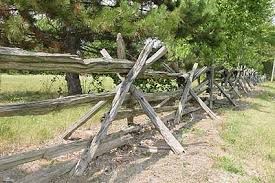Tomorrow is Canada Day and a good time to reminisce about the old days when this country was settled by Europeans. Let’s talk fences. Cedar split rail fences from the 19th century are so prevalent here in eastern Ontario that folks around here hardly noticed them. Many were sagging and falling down.
Split rail fences had many advantages for the settlers besides needing no hardware. They required few tools, could be built on almost any type of ground, did not need post holes and were relatively simple to assemble.
Rails were made by splitting cedar logs down the middle and then splitting the halves again and then again if the log was sufficiently large. The diameter of the log determined how many rails could be made. Cedar was the wood of choice because it was so plentiful and was rot resistant
A few miles outside of Smith Falls towards Brockville is a state-of-the-art split-rail fence, also called a patent fence. The fence is the width of a 100-acre farm and was probably constructed in the last 10 years or so. The area has many such fences, but this particular one is outstanding. It’s built tall and solid.
I once stopped to examine and study the fence. The soil is rocky thus there are no posts dug into the ground. Five thin posts standing up in a sort of tepee support five or six 20-ft long rails. The rails are wired into the tepee, and are also wired to a bottom short piece of rail to keep the fence from being overturned. Nails are not used in the construction. Rocks can also be piled on the bottom rail to keep it upright in a storm.
There is a man in the area who specializes in building this type of fence. I’m told if a vehicle crashes through the fence, he gets called to fix it. You can’t buy supplies at a hardware store to fix the fence. It takes special split rails.
It’s interesting how counties have different or rare types of fences. You don’t see this type of rail fence in Renfrew County (only ones to adorn newly built homes and small hobby farm properties), but it’s very common in Lanark and Leeds.
Cedar rails were usually prepared in the winter when frost was in the wood. Straight cedar trees “split like ribbon” while others with a twist to them were more of a challenge to the axe man. Settlers used five or six rails to make their fences “horse-high and bull tight.”
The spaces between the rails could be made as wide or as narrow as required for sheep, cattle or horses. Many of the split-rail fences have lasted more than a century.
You do see century-old rail fences on Renfrew County farms, but they are not like the ones in Leeds and Lanark. The common rail fences are the snake fence that zigzags across rocky woodland, and the rail fence held together by two posts with wooden crosspieces nailed to the posts. The rails rest on the crosspieces. Some are held together by wire.
Another aging wood fence seen in old pastures is the bunk or bottom block fence, built with logs notched at the ends. Each log was laid on a short log crosspiece, or bunk. Sometimes holes were augured in the bunks and wooden pegs were pounded in to hold the top bunk firmly in place.
Most of the rail fences built now are only for looks –the old look!
Have a Happy Canada Day!







![Kenopic/Smith Auction [Paid Ad]](https://whitewaternews.ca/wp-content/uploads/2018/10/advertising-100x75.jpeg)

